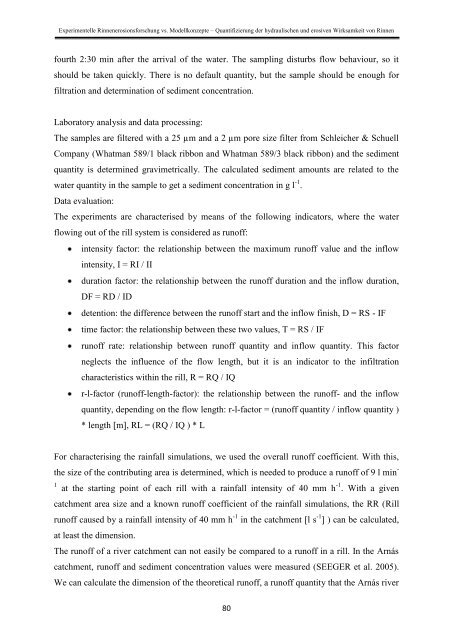Stefan Wirtz Vom Fachbereich VI (Geographie/Geowissenschaften ...
Stefan Wirtz Vom Fachbereich VI (Geographie/Geowissenschaften ...
Stefan Wirtz Vom Fachbereich VI (Geographie/Geowissenschaften ...
Create successful ePaper yourself
Turn your PDF publications into a flip-book with our unique Google optimized e-Paper software.
Experimentelle Rinnenerosionsforschung vs. Modellkonzepte – Quantifizierung der hydraulischen und erosiven Wirksamkeit von Rinnen<br />
fourth 2:30 min after the arrival of the water. The sampling disturbs flow behaviour, so it<br />
should be taken quickly. There is no default quantity, but the sample should be enough for<br />
filtration and determination of sediment concentration.<br />
Laboratory analysis and data processing:<br />
The samples are filtered with a 25 µm and a 2 µm pore size filter from Schleicher & Schuell<br />
Company (Whatman 589/1 black ribbon and Whatman 589/3 black ribbon) and the sediment<br />
quantity is determined gravimetrically. The calculated sediment amounts are related to the<br />
water quantity in the sample to get a sediment concentration in g l -1 .<br />
Data evaluation:<br />
The experiments are characterised by means of the following indicators, where the water<br />
flowing out of the rill system is considered as runoff:<br />
intensity factor: the relationship between the maximum runoff value and the inflow<br />
intensity, I = RI / II<br />
duration factor: the relationship between the runoff duration and the inflow duration,<br />
DF = RD / ID<br />
detention: the difference between the runoff start and the inflow finish, D = RS - IF<br />
time factor: the relationship between these two values, T = RS / IF<br />
runoff rate: relationship between runoff quantity and inflow quantity. This factor<br />
neglects the influence of the flow length, but it is an indicator to the infiltration<br />
characteristics within the rill, R = RQ / IQ<br />
r-l-factor (runoff-length-factor): the relationship between the runoff- and the inflow<br />
quantity, depending on the flow length: r-l-factor = (runoff quantity / inflow quantity )<br />
* length [m], RL = (RQ / IQ ) * L<br />
For characterising the rainfall simulations, we used the overall runoff coefficient. With this,<br />
the size of the contributing area is determined, which is needed to produce a runoff of 9 l min -<br />
1 at the starting point of each rill with a rainfall intensity of 40 mm h -1 . With a given<br />
catchment area size and a known runoff coefficient of the rainfall simulations, the RR (Rill<br />
runoff caused by a rainfall intensity of 40 mm h -1 in the catchment [l s -1 ] ) can be calculated,<br />
at least the dimension.<br />
The runoff of a river catchment can not easily be compared to a runoff in a rill. In the Arnás<br />
catchment, runoff and sediment concentration values were measured (SEEGER et al. 2005).<br />
We can calculate the dimension of the theoretical runoff, a runoff quantity that the Arnás river<br />
80
















